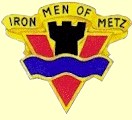 |
1918 - 1942
The
division will have a short existence at the end of
WWI and it’s still training when the Armistice is
signed. It’s dissolved in December 1918. However,
between the 2 wars, it’s a reserv division based
in Oklahoma City.
Badge
1 : The patch of the division
has the 2 letters of the state in which it is based :
OK i.e.
Oklahoma and Kansas. |
|
Badge
1 |
| |
|
| |
|
 |
1942 - 1945
The
new emblem of the division id adopted as of the Camp
Swift (1942). It is an arabic "9"
associated with a roman "V".
"V" is the first letter for the
name "Victory", the motto of the
division at this period.
Badge
2 & 3 : There’s no white around the red
9. These very first patches were manufactured in a
small quantity when the 95th ID US has been set up ;
therefore, there’re rare to find. |
| Badge
2 |
| |
|
 |
Insigne
3 : Badge of
division worn by Seymour Schnuer [ L Co/377 ] during
the WW2. (see also another badge of this soldier: Badge
6). The general
shape of the badge is not perfectly oval and the
logo is not embroidered in the center. Donation
of Seymour Schnuer
|
| Badge
3 |
|
| |
|
 |
Detail
of the badge 3 :An
effect of shade was carried out with dark blue wire
bent on the left edge from the "9" red and
"V" white.
|
| Detail
of the badge 3 |
|
| |
|
 |
Insigne
4 : On this patch, there’s
still no white around the red 9. Notice that it is
the only badge on which the "V" is not
totally enlaced with the "9". Collection
of the webmaster
|
| Badge
4 |
|
| |
|
 |
Badge
5 : On this badge, there is a
white contour around the « 9 » and a
green edging all around. It’s undoubtelly the most
used model at the time of the liberation of France
in 1944. Collection of the
webmaster
|
| Badge
5 |
|
| |
|
 |
Badge
6 : Badge of division worn by
Seymour Schnuer [ L Co/377 ] during the WW2. (see
also another badge of this soldier: Badge
6 ). Donation
of Seymour Schnuer
|
| Badge
6 |
|
| |
|
 |
Detail
of the badge 6 : Interesting
thing, a small white net is prolonged in the
"9".
|
| Detail
of the badge 6 |
|
| |
|
 |
Today
Badge
7 : Presence of the white
contour but not of the green edging which has been
replaced by a blue one, more or less thick. These
badges were manufactured after the war. There are
still manufactured today and used on the ceremony
clothes. Donation of Col
James Minor |
| Badge
7 |
|
| |
|
 |
Badge
8 : The 95th ID is again in
activity and it wears the black and green badge on
the battle dress, as every unit of the US Army. Donation
of Col James Minor
|
| Badge
8 |
|
| |
|

Badge
9
|
Badge
9 : In 1967, the
nickname given to division by the Germans, "Iron
Men of Metz", was approved for adoption by The
Institute of Heraldry. V in red represents as on the
badge of 95th ID the word "Victory". The
river in blue represents the Moselle River, crossing
point impossible to circumvent of division in
France. Indeed, that's in Lorraine that it is placed
on the first line. It is in this zone that the
division knows its first battles, in October 1944.
The fort in black represents the fortress of Metz,
"impregnable" city hitherto because of the
power of its many garrisons... After analysis of the
current photographs of US Army, this crest is
present on the service uniforms (those being placed
on the shoulder pads of the jacket) and the berets
of Division.
|

